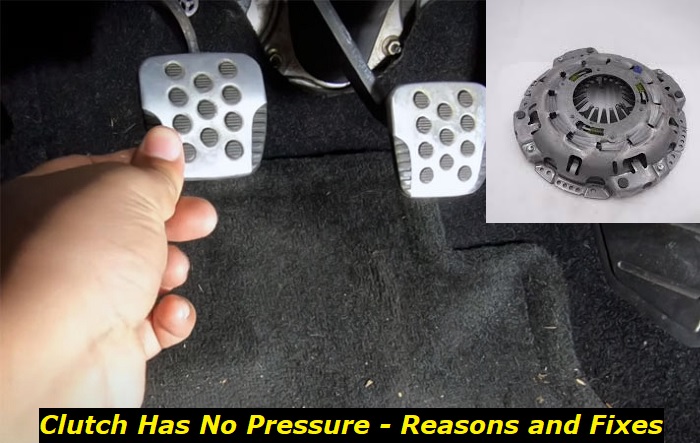Manual transmission vehicles have always been around since the motorized car was invented. Driving a manual transmission vehicle is engaging and fun. Though debatable, many people who drive manual cars argue they are able to control their vehicles better. But to enjoy driving your manual vehicle, you need to know the various systems and components that make the car move.
In our article today, we discuss the clutch. We investigate why the clutch can have no pressure and the vehicle won't go into gear. We will explore the possible causes of these issues and how best to solve them. By the time you finish reading this article, you should have a pretty good idea of what is going on in your vehicle's transmission system as far as the clutch pressure goes.

What is a clutch, and how does it work?
Almost every car has a clutch. In fact, a majority of machines, including chain saws and drills, have a clutch. A clutch's basic function is to transmit torque from a rotating driving motor to a transmission. A clutch is critical wherever there are two rotating shafts. In the case of a vehicle, the engine which produces torque is engaged or disengaged thanks to the clutch. The clutch locks the engine and the transmission, making them rotate at the same speed, or disengages the two to make them rotate at different speeds.
Your car's engine rotates all the time as long as it's running. On the other hand, the vehicle's wheels rotate when engaged to the engine. When you want to stop the vehicle, the wheels must be disengaged from the engine to avoid destroying the engine. The clutch controls the slippage between a spinning engine and a non-spinning transmission by smoothly engaging the two.
What causes the pressure to have no pressure?
Long-time drivers of manual transmission vehicles have encountered numerous issues associated with the clutch. It can be a frustrating experience for a learner before they master how to engage the clutch properly. It can be a more disturbing experience when you push the clutch pedal and realize there is no pressure. This can leave you stranded. Here are the leading causes of this issue;
1) Clutch pedal unhooking from the master cylinder
Your vehicle's clutch uses a complex mechanism that allows you to engage and disengage gears by simply pushing the clutch pedal with your foot. A hydraulic operating system that includes the clutch pedal and the master cylinder can be found in most modern vehicles. This system transmits the necessary force from the pedal onto the slave cylinder.
When the clutch pedal is unhooked from the master cylinder, the pedal will be loose, and there won't be any pressure. In other words, the pedal will be disengaged from the clutch system, and that's why the pedal will be with no pressure when the lever attached to it is disconnected.
It is easy to rectify this issue as you can do it from the comfort of your car garage. You will need a flare wrench, a replacement of the lost bolt that tightens the pedal to the master cylinder, and a pedal connecting component if lost.
2) A leaking clutch hydraulic system
The first thing to do when the clutch loses pressure and the gear won't engage is to check the hydraulics. When the seals in the master cylinder are broken or worn out, the master cylinder will start leaking. Diagnosing whether there is a leakage requires you to check under the hood, where you will find the master reservoir. If there is no leakage along the clutch fluid line connecting the reservoir and the master cylinder, it is time to check inside the car.
Under the dashboard, check using your hand at the base of the clutch pedal whether there is any fluid leaking. If you confirm clutch fluid leaks, then it means the seals inside the master cylinder are worn out and you require a new master cylinder.
Once you have tightened all the master cylinder bolts and lines, fill up the reservoir with brake fluid. You will then need to bleed the air out of the system.
The master cylinder and the slave cylinder can be a real headache when they fail. The failure of these two cylinders is caused mainly by a leakage in the system, which leads to a lack of pressure. Reduced pressure means the clutch pedal doesn't exert enough pressure to actuate the clutch fork. The driver will then have a very difficult time changing gears.
3) Lines are cross threaded
When replacing a master cylinder, you can inadvertently cross-thread the fluid lines. The clutch system is connected to the brake system, and the fluids are pressurized to make the hydraulic system work. If cross-threading is done, fluids will leak through the threads, and the clutch will fail. To prevent cross threading, first, stud the lines and bolts.
4) Air in the clutch hydraulic system
If air is in the clutch system, it will not engage as it should. There will be no pressure, and the clutch will fail to engage fully, causing a number of issues. To remove the air from the system, you will need to drain the fluid and the air out of the system and replace the fluid with new one.
You will need to first fill the clutch fluid reservoir with clutch fluid up to the recommended level. Your helper should pump the clutch a few times before pressing the pedal all the way and holding it. Using a wrench, open the bleeder screw a bit, and you should hear air hissing out and fluid coming out of the valve.
When you are done with the bleeding process, tighten the screw and have your helper release the clutch. Fill the reservoir again and repeat the process until no air is heard hissing out.
5) Mechanical malfunction
Your vehicle's clutch system comprises several components, and each has to be in good working condition for the clutch to have pressure and for the gears to engage. These mechanical parts are;
- The flywheel - This part is responsible for maintaining mass or inertia to ensure engine rotation and provide more consistent engine torque delivery. The flywheel also provides a friction surface for the friction disc. The starter motor engages using the ring gear found on the flywheel.
- The pressure plate - This is probably the most important component in the clutch system. This part applies a clamping pressure that holds the driven friction disc between it and the flywheel. You'll find that the flywheel and the pressure plate rotate together. On the face of the pressure plate, you find springs that apply pressure on the driving surface. When releasing or disengaging, the clutch levers or the diaphragm are actuated, allowing the main casting to lift off the driven disc.
- Pilot bearing - This bearing is mainly found in RWD vehicles. It is located in the back of the crank or can be found in the flywheel and is used to locate the input shaft. Failure of the pilot bearing can usually lead to premature wear of the splines and the hub of the driven disc. This then causes clutch release problems.
- Release bearing - The release bearing affords a medium between the static clutch fork, the transmission, and the rotating clutch assembly. This bearing absorbs the force to release the clutch and reduces the wear between the non-rotating parts and those rotating.
Another thing worth noting about the clutch is that the clutch fluid should be at the recommended level always for it to perform optimally. A low clutch fluid level will cause the gears to grind, and there will be vibrations when shifting the gears. The changing of gears will be sluggish, and you will experience some resistance in the gearshift lever.
You will need to practice good driving habits to avoid clutch issues and to make the whole clutch system serve you for a long time. Among the tricks to adopt include the following;
- Avoid riding the clutch
- Be decisive when changing gears
- Change gears quickly
- Disengage the clutch fully when changing gears
Be gentle on the clutch. Drag racing, towing heavy loads, and stretching the car when stuck in mud causes the clutch to wear out really fast.
Conclusion
There are instances when a malfunctioning clutch will still leave you with the ability to shift gears and at least able to reach a service station. In our case, however, the clutch will fail, and the vehicle won't go into gear, meaning you can be stranded. But before this extremity comes to be, there will be symptoms which, as a keen driver, should serve as a warning.
If you are a DIYer, you can correct this problem at a minimal cost. All you need is a flare wrench, a ratchet, a wrench extension, a bleeding screw, and a user manual of your vehicle. If any of the above-described reasons is seen not to cause the problem, then consult an expert to fix your vehicle.
About the authors
The CarAraC research team is composed of seasoned auto mechanics and automotive industry professionals, including individuals with advanced degrees and certifications in their field. Our team members boast prestigious credentials, reflecting their extensive knowledge and skills. These qualifications include: IMI: Institute of the Motor Industry, ASE-Certified Master Automobile Technicians; Coventry University, Graduate of MA in Automotive Journalism; Politecnico di Torino, Italy, MS Automotive Engineering; Ss. Cyril and Methodius University in Skopje, Mechanical University in Skopje; TOC Automotive College; DHA Suffa University, Department of Mechanical Engineering






Add comment